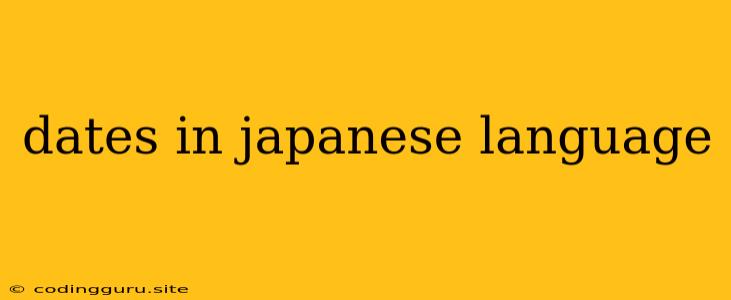Navigating the World of Japanese Dates: A Comprehensive Guide
Learning a new language is like unlocking a new world, and Japanese is no exception. With its rich history and culture, mastering the language opens doors to understanding a fascinating society. Dates are an integral part of any language, providing a framework for understanding time and events. This guide will help you navigate the nuances of expressing dates in Japanese, giving you a solid foundation for navigating conversations and cultural contexts.
How Do Japanese People Express Dates?
Unlike English, where we say "February 28th, 2023", Japanese uses a different system for expressing dates.
1. Year-Month-Day Order: The Japanese calendar places the year first, followed by the month, and lastly the day. For example, "2023年2月28日" translates to "2023 year 2 month 28 day", indicating February 28th, 2023.
2. Using Numbers: Japanese dates are typically expressed using numbers, not words. This applies to both the day and the month.
3. Era Names: A unique aspect of Japanese dates is the use of "Gengo", era names. Each era reflects the reign of a specific emperor, adding a historical context to the date. For example, the current era is "令和" (Reiwa), which began on May 1, 2019.
4. The Use of "日" (Hi): The character "日" (Hi) is used to represent the "day" in the date. However, it is usually only used at the end of the date, like "2023年2月28日" (2023 year 2 month 28 day).
Understanding Era Names: A Key to Japanese Dates
Era names (Gengo) are a fundamental part of Japanese history and culture. Each emperor's reign is given a unique name, which is used in dates during that period. For example, the current era is "令和" (Reiwa), meaning "beautiful harmony".
Here are some examples of past eras and their corresponding English translations:
- 明治 (Meiji) : 1868 - 1912
- 大正 (Taishō): 1912 - 1926
- 昭和 (Shōwa): 1926 - 1989
- 平成 (Heisei): 1989 - 2019
How to Express Dates with Era Names:
- The Era Name: Write the era name in kanji characters, followed by the year number. For example, "昭和64年" (Showa 64 year).
- Month and Day: Use numbers to express the month and day, as usual.
Example:
"昭和64年1月7日" (Showa 64 year 1 month 7 day) would refer to January 7th, 1989, the last day of the Showa era.
Common Phrases for Dates
Here are some common phrases you might encounter when discussing dates:
- 今日 (kyō): Today
- 明日 (ashita): Tomorrow
- 昨日 (kinō): Yesterday
- 来週 (raishū): Next week
- 先月 (sengetsu): Last month
- 来月 (raigetsu): Next month
Practical Tips for Learning Japanese Dates
- Start with the basics: Learn the basic structure of Japanese dates and how to read era names.
- Practice writing dates: Write out dates regularly to get accustomed to the format.
- Use resources: Utilize online tools, language learning apps, and textbooks to practice.
- Immerse yourself: Watch Japanese movies or TV shows, listen to Japanese music, and try to find opportunities to converse with native speakers.
- Don't be afraid to make mistakes: Everyone makes mistakes when learning a new language, but it's important to keep trying.
Conclusion
Mastering the art of expressing dates in Japanese is an important step towards fluency. By understanding the year-month-day order, era names, and common phrases, you'll be able to navigate a wider range of conversations and cultural contexts. Don't hesitate to practice and explore the intricacies of this fascinating language. You'll be surprised at how quickly you can become comfortable with the nuances of Japanese dates.
